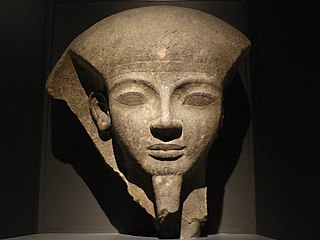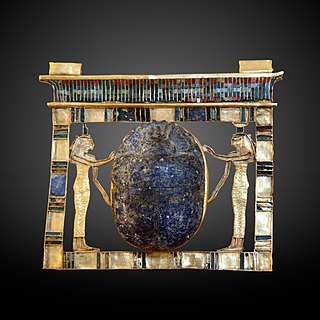
Thebes, known to the ancient Egyptians as Waset, was an ancient Egyptian city located along the Nile about 800 kilometers (500 mi) south of the Mediterranean. Its ruins lie within the modern Egyptian city of Luxor. Thebes was the main city of the fourth Upper Egyptian nome and was the capital of Egypt for long periods during the Middle Kingdom and New Kingdom eras. It was close to Nubia and the Eastern Desert, with its valuable mineral resources and trade routes. It was a cult center and the most venerated city during many periods of ancient Egyptian history. The site of Thebes includes areas on both the eastern bank of the Nile, where the temples of Karnak and Luxor stand and where the city was situated; and the western bank, where a necropolis of large private and royal cemeteries and funerary complexes can be found. In 1979, the ruins of ancient Thebes were classified by UNESCO as a World Heritage Site.

The New Kingdom, also referred to as the Egyptian Empire, is the period in ancient Egyptian history between the sixteenth century BC and the eleventh century BC, covering the Eighteenth, Nineteenth, and Twentieth dynasties of Egypt. Radiocarbon dating places the beginning of the New Kingdom between 1570 BC and 1544 BC. The New Kingdom followed the Second Intermediate Period and was succeeded by the Third Intermediate Period. It was Egypt's most prosperous time and marked the peak of its power.

Neferkare Setepenre Ramesses IX was the eighth pharaoh of the Twentieth Dynasty of Egypt. He was the third longest serving king of this Dynasty after Ramesses III and Ramesses XI. He is now believed to have assumed the throne on I Akhet day 21 based on evidence presented by Jürgen von Beckerath in a 1984 GM article. According to Papyrus Turin 1932+1939, Ramesses IX enjoyed a reign of 18 years and 4 months and died in his 19th Year in the first month of Peret between day 17 and 27. His throne name, Neferkare Setepenre, means "Beautiful Is The Soul of Re, Chosen of Re." Ramesses IX is believed to be the son of Mentuherkhepeshef, a son of Ramesses III, since Mentuherkhopshef's wife, the lady Takhat bears the prominent title of King's Mother on the walls of tomb KV10, which she usurped and reused in the late 20th Dynasty; no other 20th Dynasty king is known to have had a mother with this name. Ramesses IX was, therefore, probably a grandson of Ramesses III.

Menmaatre Ramesses XI reigned from 1107 BC to 1078 BC or 1077 BC and was the tenth and final pharaoh of the Twentieth Dynasty of Egypt and as such, was the last king of the New Kingdom period. He ruled Egypt for at least 29 years although some Egyptologists think he could have ruled for as long as 30. The latter figure would be up to 2 years beyond this king's highest known date of Year 10 of the Whm Mswt era or Year 28 of his reign. One scholar, Ad Thijs, has suggested that Ramesses XI could even have reigned as long as 33 years.

The Valley of the Queens is a site in Egypt, where the wives of pharaohs were buried in ancient times. It was known then as Ta-Set-Neferu, meaning "the place of beauty". It was most famous for being the burial site of many wives of Pharaohs. Pharaohs themselves were buried in the Valley of the Kings.

Ramesses VI Nebmaatre-Meryamun was the fifth ruler of the Twentieth Dynasty of Egypt. He reigned for about eight years in the mid-to-late 12th century BC and was a son of Ramesses III and queen Iset Ta-Hemdjert. As a prince, he was known as Ramesses Amunherkhepeshef and held the titles of royal scribe and cavalry general. He was succeeded by his son, Ramesses VII Itamun, whom he had fathered with queen Nubkhesbed.

Tomb ANB is a sepulchre located in the west of the necropolis of Dra' Abu el-Naga', near Thebes, Egypt. It may well have been intended as the burial place of the 18th Dynasty Pharaoh Amenhotep I and his mother Ahmose-Nefertari.

Psusennes I was the third pharaoh of the 21st Dynasty who ruled from Tanis between 1047 and 1001 BC. Psusennes is the Greek version of his original name Pasibkhanu or Pasebakhaenniut, which means "The Star Appearing in the City" while his throne name, Akheperre Setepenamun, translates as "Great are the Manifestations of Ra, chosen of Amun." He was the son of Pinedjem I and Henuttawy, Ramesses XI's daughter by Tentamun. He married his sister Mutnedjmet.

The Valley of the Kings, also known as the Valley of the Gates of the Kings, is an area in Egypt where, for a period of nearly 500 years from the Eighteenth Dynasty to the Twentieth Dynasty, rock-cut tombs were excavated for pharaohs and powerful nobles under the New Kingdom of ancient Egypt.
Sekhemre Shedtawy Sobekemsaf II was an Egyptian king who reigned during the Second Intermediate Period, when Egypt was fragmented and ruled by multiple kings. He was once thought to belong to the late Thirteenth Dynasty, but is today believed to be placed as a king of the Seventeenth Dynasty of Egypt.
The period of ancient Egyptian history known as wehem mesut or, more commonly, Whm Mswt can be literally translated as Repetition of Births, but is usually referred to as the (Era of the) Renaissance.

The Abbott Papyrus serves as an important political document concerning the tomb robberies of the Twentieth Dynasty of Egypt during the New Kingdom. It also gives insight into the scandal between the two rivals Pawero and Paser of Thebes.

The ancient Egyptian noble Sennefer was "Mayor of the City" and "Overseer of the Granaries and Fields, Gardens and Cattle of Amun" during the reign of Amenhotep II of the Eighteenth Dynasty of Egypt. Being a favourite of the king he accumulated great wealth. He was also allowed to place a double statue of himself and his wife in the temple at Karnak. The famous garden plan, often described is Sennefer's Garden, is more likely to be of a garden which Sennefer managed, and perhaps designed, than to be of a garden which Sennefer owned.

Paser was an ancient Egyptian noble who served as vizier during the reigns of Seti I and Ramesses II in the 19th Dynasty. He would later also become High Priest of Amun.

Ramose was an ancient Egyptian scribe and artisan who lived in Deir el-Medina on the west bank of the Nile, opposite Thebes, during the reigns of Ramesses II. He held the position of Scribe of the Tomb, the highest administrative position for a scribe in Deir el-Medina, from around years 5 to 38 of Ramesses II's reign. He was buried in a tomb in the village necropolis.

Bakenkhonsu was a High Priest of Amun in ancient Egypt during the reign of Pharaoh Ramesses II. Information about his life was found on the back of his block statue. The information on the statue provides details about the education of young Egyptian noblemen at that time and the career of priests.
Amenemipet called Pairy was a Vizier of ancient Egypt. He served during the reign of Amenhotep II and Tuthmosis IV.

The Twentieth Dynasty of Egypt is the third and last dynasty of the Ancient Egyptian New Kingdom period, lasting from 1189 BC to 1077 BC. The 19th and 20th Dynasties furthermore together constitute an era known as the Ramesside period. This dynasty is generally considered to be the start of the decline of Ancient Egypt.

The Theban Tomb TT385 is located in Sheikh Abd el-Qurna, part of the Theban Necropolis, on the west bank of the Nile, opposite Luxor. It is the burial place of the ancient Egyptian Hunefer (Haunefer), who was a Mayor of the Southern City (Thebes) during the reign of Ramesses II in the Nineteenth Dynasty.

Khaemwaset was an ancient Egyptian vizier of the South, governor of Thebes, and possibly also High Priest of Ptah during the reign of pharaohs Ramesses IX of the 20th Dynasty.
He is mainly known for being the vizier who ordered and led the investigation into the royal tomb robberies which occurred under Ramesses IX.
















